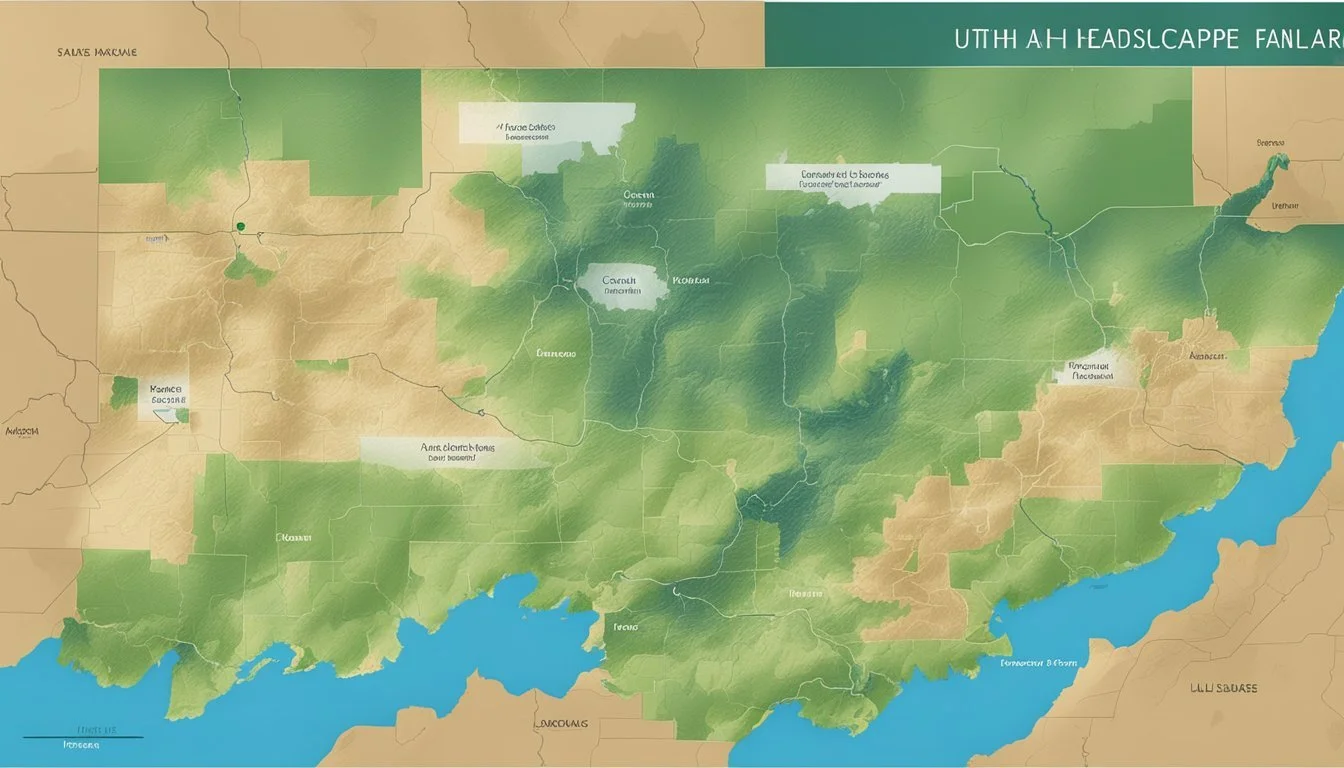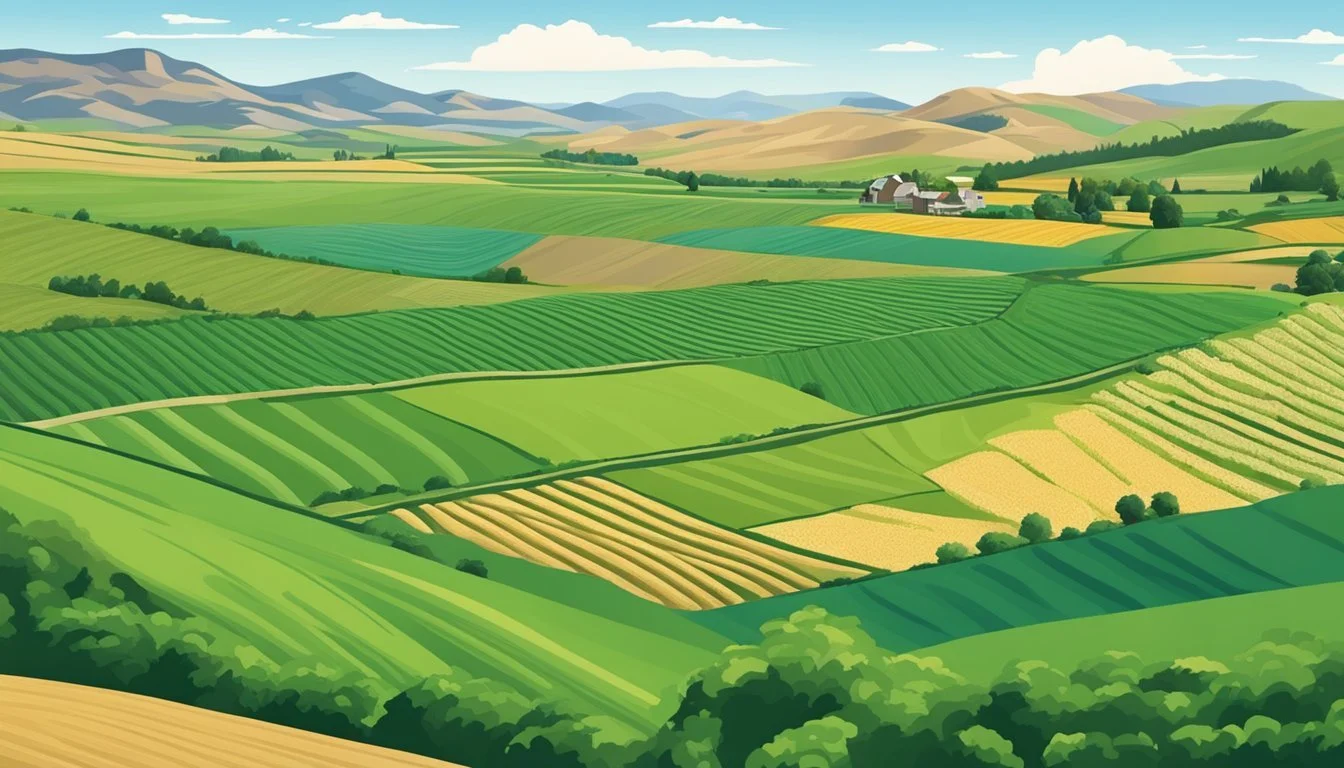Utah Farm Land for Lease
Opportunities and Options
This Article is Part of Our Guide on Navigating Agricultural Leases Across the US
Utah’s diverse landscape offers a variety of farm land for lease, catering to agricultural entrepreneurs and established farmers alike. The state's scenic terrain, which ranges from flat, fertile valleys to rugged high-elevation areas, provides a multitude of opportunities for different types of farming operations. Prospective tenants can find plots varying in size and suitability for specific crops or livestock, reflecting Utah's capacity to host a wide range of agricultural activities.
When considering farm land for lease in Utah, it’s essential to assess factors such as soil fertility, water availability, and climate. Each region of Utah, from the mountainous northern counties to the warmer southern areas, presents unique conditions that can influence agricultural productivity. Land leasing in Utah permits flexibility and can be a practical option for farmers seeking to expand their operations without the upfront costs associated with purchasing property.
The market for leasing farm land in Utah is dynamic, with properties available across the state, including near urban centers like Salt Lake City and in more remote rural areas. Land leasing agreements can vary, with terms that accommodate different farming scales and budgets. This flexibility supports Utah’s agricultural community by providing options that can help new farmers start their business or allow established farmers to experiment with different land parcels or farming methods.
Understanding Farm Land Leasing in Utah
When exploring farm land leasing in Utah, one should consider various lease types, understand the legal framework, recognize the benefits, and know how to determine lease rates.
Types of Leases and Contracts
In Utah, individuals seeking to lease farm land encounter several contract options, each tailored to suit different agricultural activities. Two prevalent lease types are:
Cash Rent Lease, where the lessee pays a fixed amount typically per acre.
Crop Share Lease, where landowner and lessee share the costs and revenues of the crops produced.
Utah's Legal Framework for Leasing
Utah's legal statutes govern the creation and enforcement of agricultural leases, ensuring clarity and fairness in the agreements. Lessees and landowners must adhere to regulations that:
Define lease term limits.
Outline maintenance responsibilities.
Address land use permissions and restrictions.
Benefits of Leasing Farmland
Leasing farmland in Utah offers considerable benefits to both landowner and lessee. For landowners, it provides a steady income and ensures their land remains productive. Lessees gain access to land for agricultural use without the major capital investment of buying. This collaborative relationship helps preserve Utah’s agricultural heritage and contributes to local food production.
Determining Lease Rates
Determining fair lease rates in Utah takes into account factors like:
Land quality and location.
Previous land use and crop history.
Current market conditions and average rental rates in the region.
By considering these factors, both parties can negotiate a lease rate that is equitable and sustainable.
Finding Available Farm Land to Lease
When seeking farm land for lease in Utah, prospective tenants can utilize online marketplaces, tap into local resources, and employ mapping tools to identify suitable properties.
Land Listing Platforms and Marketplaces
Online platforms such as LandCashin and LandSearch offer extensive listings of available farm land for lease in Utah. Interested parties can browse various properties according to size, location, and leasing cost. These marketplaces provide brief descriptions and often mention specific regions, such as Herriman or St. George, as well as the acreage available for lease.
Local Resources and Deal Alerts
Potential lessees should engage with local agricultural resources, including county extension offices and farm bureaus, which can often provide insider information on land availability not listed online. Subscribing to deal alerts from real estate websites and platforms dedicated to commercial real estate, like Crexi, can also be a proactive way to stay informed about new leasing opportunities as soon as they hit the market.
Using Maps to Locate Land
Mapping technologies offer a visual approach to finding farm land for lease. Prospective lessees can use satellite imagery and mapping services to survey the terrain, access routes, and the proximity to necessary resources. This geographic perspective is key for assessing the suitability of land for specific agricultural needs.
Factors to Consider When Leasing
When considering leasing farm land in Utah, potential lessees must evaluate several crucial aspects to ensure the land meets their agricultural needs and the lease terms are favorable for the longevity of their farming operations.
Soil Quality and Land Conditions
A lessee should assess the soil quality, as it directly affects the types of crops that can be grown and the potential yield. Soil testing for pH levels, nutrient content, and composition is imperative. Additionally, the overall land conditions, including topography and water resources, must be conducive to the intended agricultural use.
Lease Duration and Terms
Lease Duration:
Short-term lease: Typically 1-3 years
Long-term lease: Could extend beyond 5 years
The lessee should ensure that the lease duration aligns with their farming plans. They must also closely examine the renewal options and termination clauses to safeguard their investment.
Lease Terms:
Renewal options: Should be stated clearly
Termination clauses: Must specify circumstances under which a lease can be terminated
Budgeting for Lease Expenses
A lessee must consider the financial implications of the lease. This involves evaluating the rent structure, which may be a fixed amount or variable based on profit sharing or crop yields.
Rent Structure Examples:
Type Description Fixed Rent A set amount paid annually Variable Rent Adjusted based on various factors like revenue or yield
Understanding these costs is paramount for financial planning and maintaining the viability of the agricultural business throughout the term of the lease.
Regions and Counties for Farm Land Leases
Utah offers diverse regions for farm land leases, each with unique opportunities and characteristics. Whether in urban peripheries or rural heartlands, lessees can find suitable land for various agricultural pursuits.
Popular Farming Areas in Utah
In Utah, regions renowned for farming include the fertile Cache Valley, the expansive Uinta Basin, and the southern stretch near St. George. These areas are favored for their conducive climates and soil conditions which support a range of crops and agricultural activities.
Cache Valley: Rich in agricultural history, offering lush farmland.
Uinta Basin: Known for larger tracts of land, ideal for extensive farming.
Southern Region near St. George: Has a warmer climate, supporting a variety of produce.
County-Specific Leasing Opportunities
Each county in Utah presents specific leasing opportunities that cater to different needs. Salt Lake County, Washington County, and Cache County are notable examples:
Salt Lake County: Proximity to urban markets caters to smaller farm operations.
Washington County: Near St. George, offers an extended growing season.
Cache County: Features both large and small leasehold properties catering to dairy farms and crop production.
Differences Between Urban and Rural Leases
The contrast between urban and rural leases in Utah is evident in terms of land size, price, and farming practices.
Urban Leases:
Typically smaller in size
Higher cost per acre
Often focus on high-value, niche markets or organic farming
Rural Leases:
Larger expanses of land
More competitive pricing
Suited for traditional, large-scale agricultural ventures
Utah's diverse landscape offers ample opportunities for farm land leases, from the booming southern cities to the quiet, wide-open rural counties.
Specifics About Crop Farm Land in Utah
In Utah, the leasing of crop farm land is contingent on understanding the specific agricultural nuances of the region. This includes recognizing the diversity in crop types, the irrigation requirements and water rights, and the practices that align with organic and sustainable farming.
Types of Crops and Suitability
Utah's agriculture is varied, due to its unique geographical features and climates across the state. The land is generally categorized based on suitability for different crops:
Northern Utah: Known for grains like wheat and barley.
Central Utah: Suitable for alfalfa and hay due to higher elevation.
Southern Utah: Favors the growth of fruits and vegetables, such as apples and onions, with a warmer climate.
Each area provides an optimal environment for specific crops, which should guide lessees in selecting appropriate farm lands.
Irrigation and Water Rights
Water is a precious resource in Utah's arid climate, making irrigation systems and water rights critical factors for crop farming:
Irrigation: Relies heavily on canals, ditches, and pivot systems to distribute water.
Water Rights: Lessees must secure water shares or rights that are often attached to the land itself.
Proper irrigation and legal access to water are essential for high-yield and sustainable crop production.
Organic and Sustainable Farming Practices
Organic and sustainable farming practices are growing trends in Utah's agriculture, marked by:
Organic Certification: Requires adherence to national standards without synthetic pesticides or fertilizers.
Sustainable Techniques: Include crop rotation, reduced tillage, and conserving water.
Farmers and lessees interested in sustainable agriculture need to be familiar with these practices and the local regulations governing them.
Commercial Opportunities and Real Estate Considerations
In assessing Utah's agricultural real estate market, one must consider both the investment upsides and the intricacies of commercial lease agreements.
Investment Potential in Farm Land
Investing in farm land in Utah presents a robust opportunity as the state offers diverse agricultural real estate options. Utah farm land typically shows promise for both appreciation in value and income generation through leasing. Investors should analyze local market trends, including lease rates and land valuation, for properties ranging from small plots to extensive acreage.
Navigating Commercial Lease Agreements
When entering a commercial lease agreement for farm land in Utah, attention to detail is paramount. Lease terms can vary significantly, with some properties offering short-term leases and others seeking long-term tenants. It is critical for both lessors and lessees to thoroughly review lease provisions including, but not limited to, use restrictions, improvement allowances, and maintenance obligations. Utilizing the expertise of a real estate attorney can be beneficial in clarifying the implications of complex lease terms.
Working with the Trust Lands Administration
The Utah Trust Lands Administration (TLA) plays a vital role in managing agricultural leases, providing opportunities for local farmers and supporting state beneficiaries. It ensures that Trust Lands are responsibly leased for agricultural purposes to foster economic development and benefit public institutions.
Available Trust Lands for Lease
Trust Lands available for lease are diverse, spanning commercial, industrial, residential, agricultural, and other uses. Agricultural leases on Trust Lands are specifically designed for farming activities, offering local farmers a chance to cultivate on state-managed land. Details on the types and locations of available leases can be accessed through the TLA's comprehensive digital platforms. Prospective lessees can view maps and documents to find suitable farmlands.
Contacting the Administration
For inquiries and assistance, contacting the TLA is straightforward. Interested parties can reach out through the TLA's official "Contact Us" channels, which include email, phone, and in-person consultations. These channels provide direct communication with the administration for lease applications, questions regarding specific properties, and guidance through leasing processes.
Understanding the Role of Trust Lands
The Trust Lands are a set of properties held in trust by the TLA for the benefit of various state institutions, such as public schools and hospitals. The administration is tasked with stewarding these lands to generate revenue through activities like leasing for farming. Understanding this stewardship role is essential for lessees, as the Trust Lands are managed not only for economic gains but also for the long-term benefit of the institutions they support.






